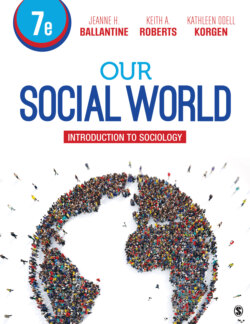Читать книгу Our Social World - Kathleen Odell Korgen - Страница 137
Symbolic Interaction Theory.
ОглавлениеHow amazing it is that babies learn to share the ideas and meanings of complex cultures with others in those cultures. Symbolic interaction theory considers how we learn to share the meanings of symbols, whether material or nonmaterial. Cultures contain many symbols, such as rings, flags, and words that stand for or represent some thing or some idea. A ring means love and commitment. A flag represents national identity and is intended to evoke patriotism and love for one’s country. A term such as middle class conjures up images and expectations of what that term means, a meaning shared with others in that group. Together in our groups and societies, we define what is real, normal, and good.
Symbolic interaction theory maintains that our humanness comes from the impact we have on each other through these shared understandings of symbols that humans have created. When people create symbols, such as a new greeting (e.g., a fist bump instead of a handshake) or a symbolic shield for a fraternity or sorority, they come to have an existence and importance for the group.
Symbolic interaction theory pictures humans as consciously and deliberately creating their personal and collective histories. The theory emphasizes the part that verbal and nonverbal language and gestures play in the shared symbols of individuals and the smooth operation of society. More than any other theory in the social sciences, symbolic interaction stresses the active decision-making role of individuals—the ability of individuals to do more than conform to the larger forces of the society.
Many of our definitions of what is “normal” are shaped by what others around us define as “normal” or “good.” The social construction of reality is the process by which individuals and groups shape their reality through social interaction. Our construction of what we see as reality, influenced by our social relations, has a profound effect on our daily lives, our life chances, and what we believe is possible in our lives. One illustration of this is the notion of what is beautiful or ugly. In the late 18th and early 19th centuries, in Europe and the United States, beaches were considered eyesores because there was nothing there but crushed stone and dangerous water. A beach was not viewed as a place to relax in a beautiful environment. Likewise, when early travelers to the West encountered the Rocky Mountains, with soaring granite rising to snow-capped peaks, the idea was that these were incredibly ugly wounds in the earth’s surface. The summits were anything but appealing. We now see both as beautiful, but the social construction of scenery has not always been so (Lofgren 1999, 2010). So even what we experience as relaxing and peaceful in nature is shaped by how our society constructs those experiences.
▲ In the late 1700s and early 1800s, this mountain view would have been considered an eyesore—too ugly to enjoy and an obstacle to progress. The social construction of reality—the definition of what is beautiful in our culture—has changed dramatically over the past 2 centuries.
© Design Pics Inc/National Geographic Creative
This notion that individuals shape culture and that culture influences individuals is at the core of symbolic interaction theory. Other social theories tend to focus on the meso and macro levels.
Thinking Sociologically
Think about how you communicate with one or more of your close friends. What are some of the symbols you use to communicate with one another? How do these forms of communication indicate that you are close friends and help you feel connected to them?
